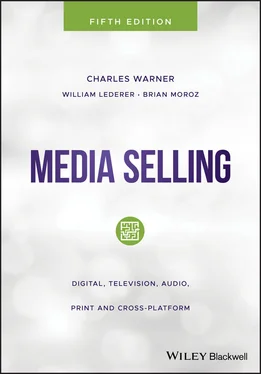The result of the research can be summarized as showing that character and doing the right thing is more profitable in the long run. Good ethics are good business.
1 What are the five rationalizations some people use for their unethical behavior?
2 What are the four reasons why people are inclined to behave unethically?
3 What are the Five Cs of ethical responsibility for media salespeople?
4 What are the Don’ts for media salespeople?
5 What are the Dos for media salespeople?
6 What are the three rules of the Ethics Checklist?
7 Explain transparency.
Project #1:Go to the Web and search the websites of several major media companies and see if you can find any statements about ethical behavior, standards of conduct, corporate citizenship, or corporate responsibility. Then, go to the websites of major advertisers such as ATT, P&G, Ford, Google, Apple, or Amazon, and see if they have any statements about ethical behavior, standards of conduct, corporate citizenship, or corporate responsibility. What did you discover?
Project #2:Go to the Downloads section of the Media Selling website ( www.mediaselling.us) and download “A Salesperson’s Dilemma.” Read the case carefully and then complete the assignment at the bottom of the case.
1 Blanchard, Kenneth and Peale, Norman V. 1988. The Power of Ethical Management. New York: William Morrow.
2 Davis, Keith, Frederick, William C., and Blostrom, Robert L. 1980. Business and Society: Concepts and Policy Issue. New York: McGraw‐Hill.
3 Gardner, Howard, Csikszentmihalyi, Mihaly, and Damron, William. 2001. Good Work: When Excellence and Ethics Meet. New York: Basic Books.
4 Kiel, Fred. 2015. Return on Character. Boston, MA: Harvard Business Review Press.
5 Seidman, Dov. 2007. How: Why How We Do Anything Means Everything…in Business (and in Life). Hoboken, NJ: Wiley.
1 Dov Seidman’s LRN corporate website ( www.lrn.com/index.php)
2 Securities and Exchange Commission Public Company filing ( www.sec.gov/edgar.shtml)
3 Association of National Advertisers ( www.ana.net/content/show/id/industry‐initiative‐media‐transparency‐report)
4 Association of American Advertising Agencies ( www.aaaa.org/4as‐statement‐media‐transparency‐recent‐k2‐report)
1 1“Voice of the sales leader.” 2001. Leading the Charge. Sales Executive Council.
2 2Ibid.
3 3Giles, Sunnie. 2016. “The Most important leadership competencies, according to leaders around the world.” Retrieved from https://hbr.org/2016/03/the‐most‐important‐leadership‐competencies‐according‐to‐leaders‐around‐the‐world.
4 4Seidman, Dov . 2007. How: Why How We Do Anything Means Everything…in Business (and in Life) . Hoboken, NJ: Wiley.
5 5Ibid.
6 6Ibid.
7 7Ibid.
8 8Stone, Brad. 2007. “Tell‐all PCs and phones transforming divorce.” Retrieved from http://www.nytimes.com/2007/09/15/business/15divorce.html.
9 9Bryant, Adam. 2017. “How to be a C.E.O., from a decade’s worth of them.” Retrieved from https://www.nytimes.com/2017/10/27/business/how‐to‐be‐a‐ceo.html.
10 10Ibid.
11 11Loechner, Jack. 2017. “Information industry outlook, 2018.” Retrieved from https://www.mediapost.com/publications/article/309126/information‐industry‐outlook‐2018.html.
12 12Bennak, Frank . 2019. Leave Something on the Table: And Other Surprising Lessons for Success in Business and Life . New York: Simon & Schuster.
13 13Davis, Keith , Frederick, William C. , and Blostrom, Robert L. 1980. Business and Society: Concepts and Policy Issue . New York: McGraw‐Hill.
14 14Gardner, Howard , Csikszentmihalyi, Mihaly , and Damron, William . 2001. Good Work: When Excellence and Ethics Meet . New York: Basic Books.
15 15Jensen, Michael. 2001. “Corporate budgeting is broken – Let's fix it.” Harvard Business Review.
16 16Blanchard, Kenneth and Peale, Norman V. 1988. The Power of Ethical Management . New York: William Morrow.
17 17“Media transparency initiative: K2 report.” Retrieved from https://www.ana.net/content/show/id/industry‐initiative‐media‐transparency‐report.
18 18Ibid.
19 19“4A’s statement on media transparency and the recent K2 report.” Retrieved from https://www.aaaa.org/4as‐statement‐media‐transparency‐recent‐k2‐report.
4 The AESKOPP Approach, Attitude, and Goal Setting
Charles Warner
The AESKOPP Approach
Key Elements and Core Competencies of the AESKOPP Approach
Attitude and Goal Setting
Goal‐Setting Theory and Objective‐Setting Practice
Take Full Responsibility for Your “Cycle of Success”
The AESKOPP approach was mentioned in Chapter 2as one of the approaches to selling in the digital era. The AESKOPP approach is a generalization, a simplification of some underlying, universal sales principles and provides a framework for coaching, planning, executing, and evaluating sales performance. It posits that successful selling requires Attitude (A), Emotional Intelligence (E), Skills (S), Knowledge (K), Opportunities (O), Preparation (P), and Persistence (P):

Notice that each element in the above formula is multiplied by the others. Just as in a mathematical formula, if any one of the elements is not present, then the result is zero success, because any element multiplied by zero is zero. Thus, all of the elements must be present for a successful result – getting customers and keeping them.
The AESKOPP Approach
Definitions
The following are definitions of each of the seven AESKOPP elements.
Attitude is having the desire and motivation to be a salesperson and having the proper mind‐set to do it. If you have the skills, the knowledge, and the opportunities to sell but have no desire or motivation to do so, you will not be successful. Later in this chapter are more details on attitudes and how to control and improve them.
Emotional intelligence is the ability to understand yourself and others so you can develop empathy and rapport with people and manage relationships successfully. Chapter 5presents more details on how to increase your emotional intelligence.
Skills are the ability, improved through preparation and deliberate practice, to use your knowledge of sales techniques, methods, and tools. For salespeople, it is understanding the techniques of prospecting and qualifying, researching insights and solutions, educating, proposing, negotiating and, closing, and customer success (account management). Chapters 9through 14will have in‐depth details about these skills and how to improve them.
Knowledge means knowing the product you are selling in depth – knowing more about it than your customers do so you can educate them. For salespeople, it means having information not only about their own product and its underlying technology, but also about measurement and data analysis, about marketing and advertising, about a customer’s business, and about competitive media. Chapters 15through 24will cover these knowledge areas.
Читать дальше













